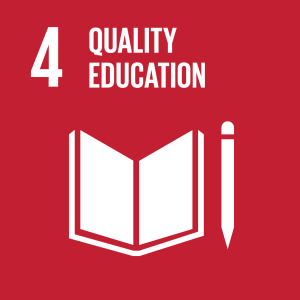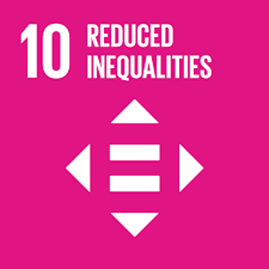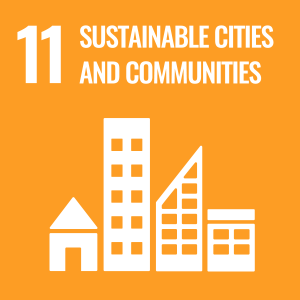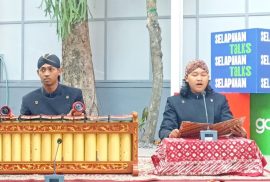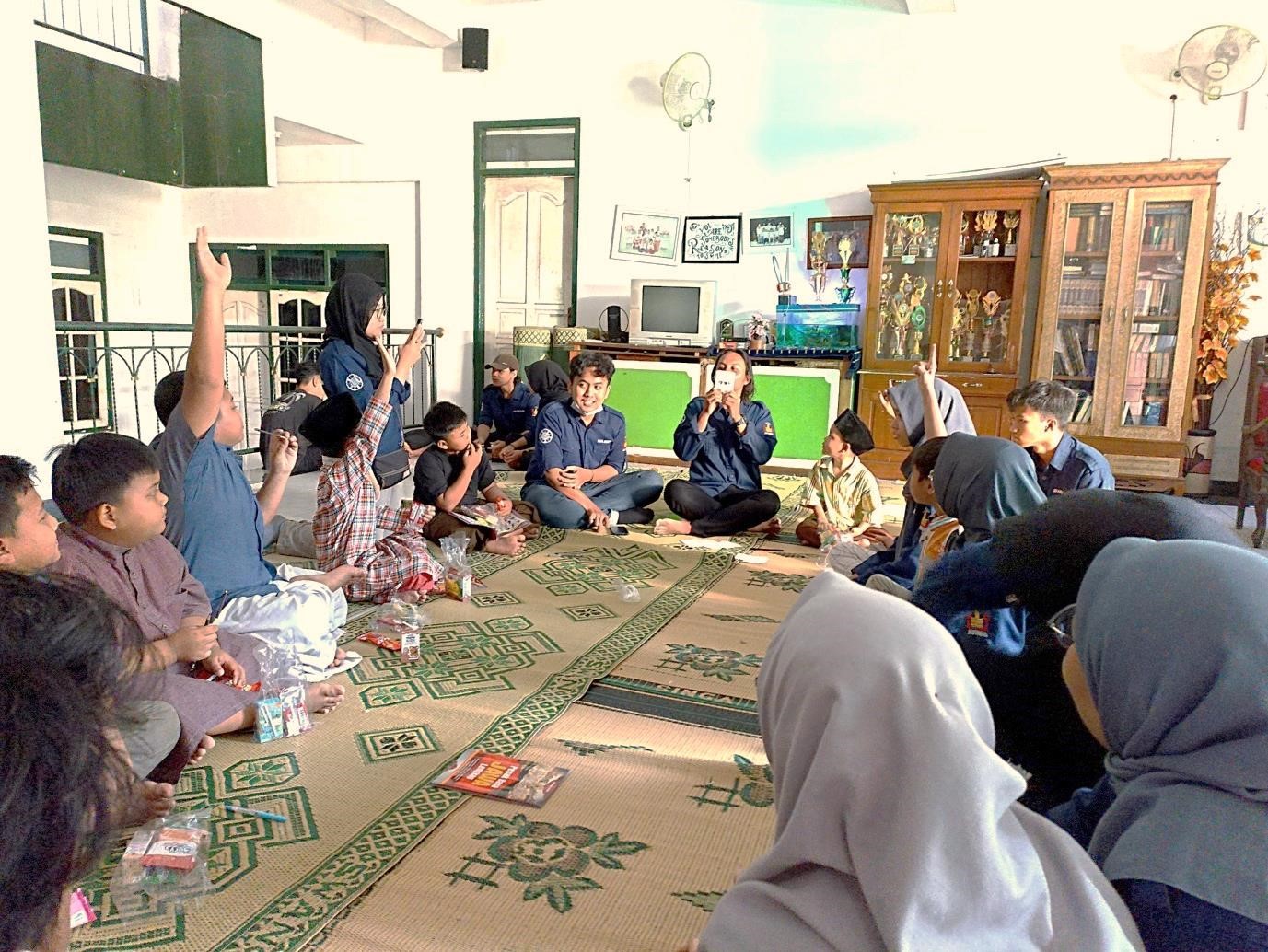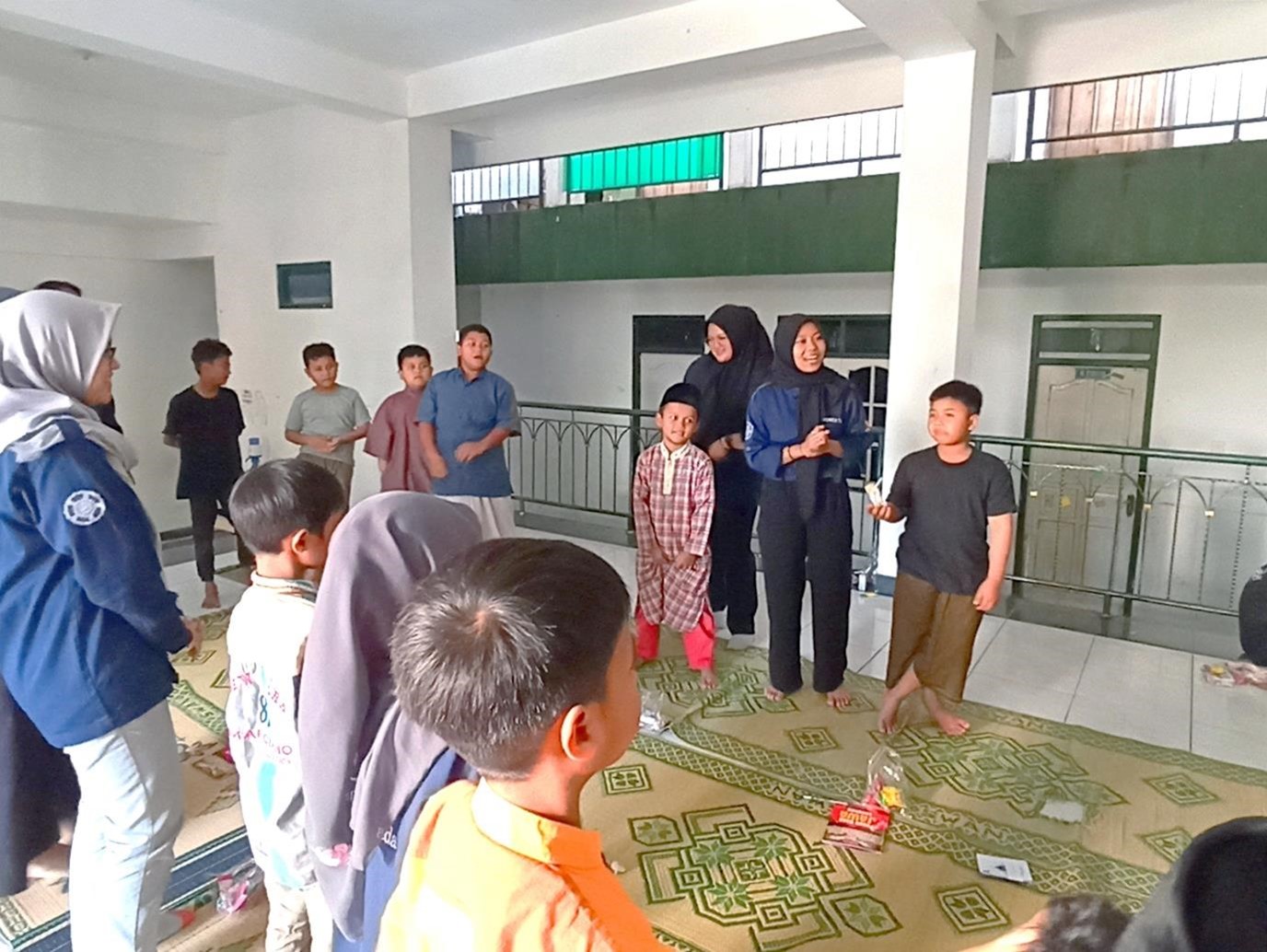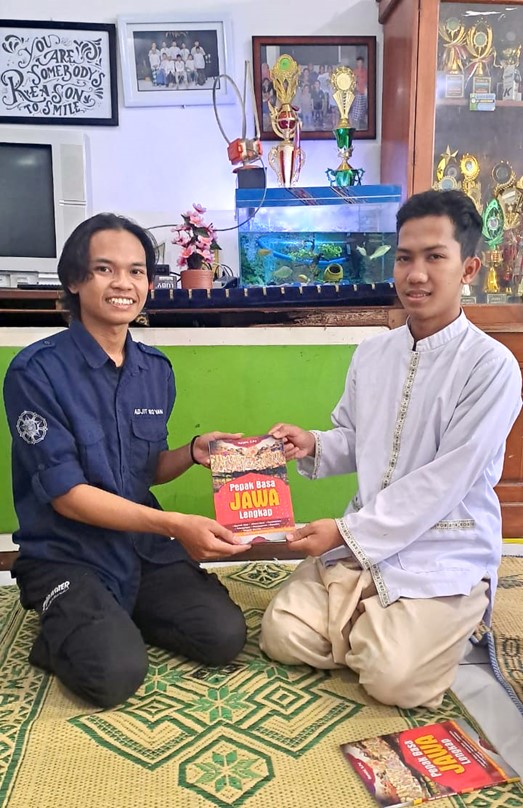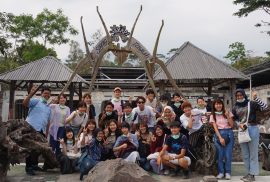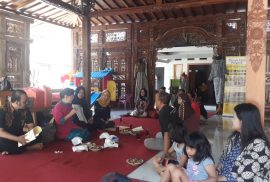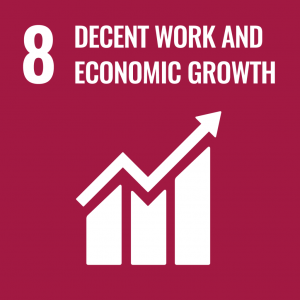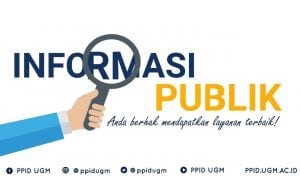- Home
- COMMUNITY SERVICES
- COMMUNITY SERVICES
- page. 4
COMMUNITY SERVICES
Students of the Javanese Language, Literature, and Culture Program Present Sekar Dhandhanggula at Selapanan Talk#1 Pusaka Jawa UGM
College StudentNews Friday, 29 September 2023
Yogyakarta - On Friday (09/10/2023), two students from the Javanese Language, Literature, and Culture Program, namely Rafael Raga B. P. and Affan Akbar, performed the Macapat song sekar Dhandhanggula in the Selapanan Talk event organized by Pusat Kajian Jawa (the Center for Javanese Studies) or Pusaka Jawa UGM.
The Sekar Dhandhanggula sung by Rafael Raga B.P. is the 13th stanza from Serat Jampi Susah written by R. Pujaarja in 1918. The performance was accompanied by the gender musical instrument played by Affan Akbar, using the Slendro Pathet Sanga tuning. Here is an excerpt from Sekar Dhandhanggula in Serat Jampi Susah stanza 13:
Rèhning kabèh ihtiyaring jalmi
Ora kêna lamun dèn têtêpna
Kang têtêp amung kodraté
Pêrlu apa dèn ulur
Iku kêna kinarya mirit
Marang waris kang waras
Aja mèlu-mèlu
Anglalu luru sangsara
Saranané mung narima jroning ati
Ing mêngko arêp apa
After the performance, Rafael Raga B.P. explained the meaning contained in the song. He stated, "In this song, R. Pujaarja expresses his view that regardless of the results and predetermined fate, effort remains important in one's self-development and providing wisdom to others. The perspective on destiny is crucial because the weight of problems and difficulties in life can be overcome with a narima (Receiving) attitude."
Furthermore, he added, "R. Pujaarja then emphasizes a question, 'ing mêngko arêp apa?' (what will you do in the future?), which invites us to reflect and introspect while moving forward towards the future. With such an attitude, it is hoped that the Javanese community can nurture their mental health to achieve a good ultimate goal, which is khusnul khotimah (a good end of life), bali marang sangkan paaraning dumaid (returning to the Creator.)"
The Selapanan Talk event is a routine activity held every 35 days. On this occasion, the theme discussed was "Javanese-Style Mental Health," and it invited two main speakers, Rudy Wiratama, S.I.P., M.A., a lecturer from the Javanese Language, Literature, and Culture Program at UGM, and Salma Dias Saraswati, CEO and Co-Founder of Tenang. This event serves as an important platform for discussing and understanding Javanese values in giving meaning to the soul and its application to mental health issues, especially among today's younger generation.
HMJ KAMASTAWA Holds Event ‘Javanese Literature Sharing and Teaching’ at Al Wahhaab Orphanage
College StudentNewsStudent's Activity Tuesday, 26 September 2023
On Sunday (13/08/2023), the Social Community Division in collaboration with the Scholarly Division of the Student Association of the Department of Javanese Literature (HMJ KAMASTAWA) successfully organized the event 'Javanese Literature Sharing and Teaching.' This program resulted from the collaborative initiative of the Social Community Division and the Scholarly Division.
The Javanese Literature Sharing and Teaching event took place at the Al-Wahhaab Sinar Melati 11 orphanage, located at Jl. Wijaya Kusuma Gg. Arjuna No. RT. 01/14, Dero, Condongcatur, Depok district, Sleman Regency, Special Region of Yogyakarta. A total of 10 children of various age groups, ranging from toddlers to first-year junior high school students, participated in this activity.
The event commenced with an introduction session between the participants and the orphanage children, followed by interactive lessons in writing and reading using flashcards. This series of learning was followed by a quiz session involving the use of these flashcards. Subsequently, the atmosphere became more enjoyable with games and singing traditional Javanese children's songs together.
Puzzle game by guessing the names of objects in Javanese language
Play and sing the traditional Javanese children's songs together
The enthusiasm displayed by the children was palpable, from the beginning to the end of the event, especially during the awarding of small prizes as tokens of appreciation for their participation in the flashcard quiz. In addition to the prizes, HMJ KAMASTAWA also provided Javanese language guidebooks (pepak basa Jawa) as an effort to introduce and cultivate an interest in Javanese culture among the children in the orphanage.
Handover of mementos from HMJ KAMASTAWA to the Al-Wahhaab Orphanage.
Though the contributions made might be modest, the significant hopes and sincere intentions to share and impart knowledge about Javanese literature consistently underpinned every step of the 'Javanese Literature Sharing and Teaching' program carried out by HMJ KAMASTAWA. This program provides a valuable experience in bridging the academic world with society, supporting cultural and literary development among children.
(International Summer Course on Indonesian as a Foreign Language: through an Exploration into Javanese Culture)
College StudentNewsSDGSStudentStudent's Activity Thursday, 14 September 2023
This activity was organized by the Javanese Literature Study Program at Gadjah Mada University in collaboration with Osaka University which has been established since 2017. This year is the third year this activity has been held.
The Indonesian language short course has the goal of being an introduction to Javanese culture so that it can improve Indonesian language skills, both orally and in writing from the results of exploration of Javanese culture in Yogyakarta and Central Java.
Course Description. This Indonesian Short Course through Javanese Cultural Exoticism is a manifestation of teaching Indonesian to foreign speakers (BIPA) which was held in Yogyakarta and Central Java by inviting approximately 10 expert lecturers from Asia, Australia, Europe and America. This activity was attended by 27 Japanese students from Osaka University who were devoted to the Graduate School of Language and Culture Studies/School of Foreign Studies. The learning will be carried out for 9 days.
Learning Outcomes. Participants are expected to be able to demonstrate understanding and actively practice Indonesian, both in written and spoken form. In addition, participants are also expected to be able to produce written and oral products as well as develop the insights they have gained during the short course.
Method. The teaching method used in this Indonesian short course is a combination of face-to-face and virtual meetings. Meanwhile, the learning process is carried out by explanation, collaborative learning, self learning, and structured assignments. Theoretical knowledge is conveyed asynchronously (and some synchronous topics, offline) which is then followed by excursions to cultural heritage sites. There was also an interview session with Java Study Program students as tutors.
Time and place. The Indonesian short course will be held on 16 - 24 September 2022 in Yogyakarta and Central Java.
Implementation Schedule
The schedule can be viewed and downloaded via the link below:
http://bit.ly/JadwalKursusSingkat
Authors:
Early Anggra
Vighna Hernawan
Bayat Sub-district, which belongs to Klaten Regency, is located in the southern corner of the region, bordering Gunungkidul Regency, Yogyakarta Special Region to the south, Cawas Sub-district to the east, Wedi Sub-district to the west and Trucuk Sub-district to the north. Bayat Sub-district is located in a limestone mountainous area parallel to the Gunungkidul region, so the appearance of the area is hilly and the majority of its citizens do not depend on farming, but many work as craftsmen, ranging from pottery, various kinds of stone tools, to batik cloth.
Bayat sub-district is an important region in history, even though it is not located in the center of government. This is evident from various stories about the area, many of which are associated with a figure who lived around the 16th century, named Ki Ageng Pandanaran. He was a regent of Semarang who resigned from power and chose to spread Islam under the title Sunan Tembayat in this area until the end of his life. In addition to the figure of Sunan Tembayat, this area also has many other historical figures who came from the transition of the Majapahit era to Demak Bintara, such as Seh Sabuk Janur, Ki Ageng Becik, Seh Domba, Ki Ageng Konang, Ki Ageng Menang Lase, Ki Ageng Santri, Pangeran Menangkabo and Panembahan Jiwa. They have their own stories in the context of their roles as leaders of the local community since the days of Demak, Mataram until it was split into Surakarta and Yogyakarta. This shows that this area, apart from its old age, also has its place in historical dynamics.
Bayat District has approximately ten batik industry centers with their uniqueness and specialization. Several batik production centers in the Bayat sub-district include stamped batik in Beluk Village, hand-written batik in Needle Village and Kebon Village, and lurk woven batik in Tegalrejo Village. The batik industry in Bayat has been hereditary and has become one of the regional suppliers of batik cloth to the Klewer market in Surakarta and Beringharjo in Yogyakarta several decades ago. Batik produced in the Bayat area itself has many variations, ranging from classic batik which has a characteristic color sogan for jarit or nyamping, modern batik with natural colors like indigo (indigovera), contemporary motives for consumption fashion, and the tastes of international buyers, to the combination of luck and batik in media other than fabrics such as wood batik, leather batik and so on.
As an area that is thick with historical nuances, Bayat District certainly has a lot of local wisdom, one of which is in the form of traditional songs, spells, prayers, tattoos, and wise advice that is useful for the community to address various phenomena of life in the present and anticipate things that may occur in the future. Besides that, a lot petilasan or the historical footprint of many figures from the eras of Hinduism, and Islam to the last Javanese kingdoms in this region shows that of course there will be many related folktales to be found, which apart from being able to function as a medium for historical reminders also contain various cultural values. In addition, the Bayat area has also become an important part of the history of Javanese literature, because at the gate of the tomb of Sunan Tembayat was also found the sengkalan or chronogram, titles Murti Sarira Jleging Ratu(1448) and Wisaya Hanata Wisiking Ratu(1555), whose typeface is archaic, contemporaneous with texts found in coastal areas, including Primbon Sunan Bonang which is stored in the Asian Library Library, Leiden University. These things have not been optimally exposed especially about Bayat as one of the handicraft industry centers in Klaten. Community Service (PPM) carried out by the Javanese Literature Study Program, Language and Literature Department, Faculty of Cultural Sciences, Universitas Gadjah Mada, Yogyakarta this time will focus on developing batik motifs filled with folklore and local wisdom with Javanese written media, both modern and modern Javanese styles. known today as well as the 'Sunan Tembayat style' which is depicted in ancient tomb complexes in this area.
The aim of the PPM Javanese Literature Study Program in Bayat District, Klaten Regency, which was held on July 15, 2019, was to strengthen Bayat's identity as a religious and historical tourism destination, a center for the UMKM industry (Small, Micro and Medium Enterprises) in the handicraft sector as well as one of the areas with a specific in the field of culture, besides that, it is also to form a community group that manages the potential for cultural arts and history in Bayat District, Klaten Regency.
The expected results in community service activities are Bayat District as the Study Program Foster Area, more specifically to strengthen the existence of Bayat District, Klaten Regency as an area that has a distinctive and strong-rooted cultural character.
The results obtained from the activity 'Community Service: Development of Batik Motifs Based on Folklore and Javanese Script in Bayat District, Klaten Regency' is the creation of the 'Udan Riris Majaarum' batik motif. This motif can be used by the community as a batik motif characteristic of the Needle Village, Bayat District. In addition to batik motifs outcome of this activity is the article 'Creating a New Motive for the Identity of Needle Village, Bayat District, Klaten Regency' which is planned to be published in the Bakti Budaya Journal and activity documentation.


